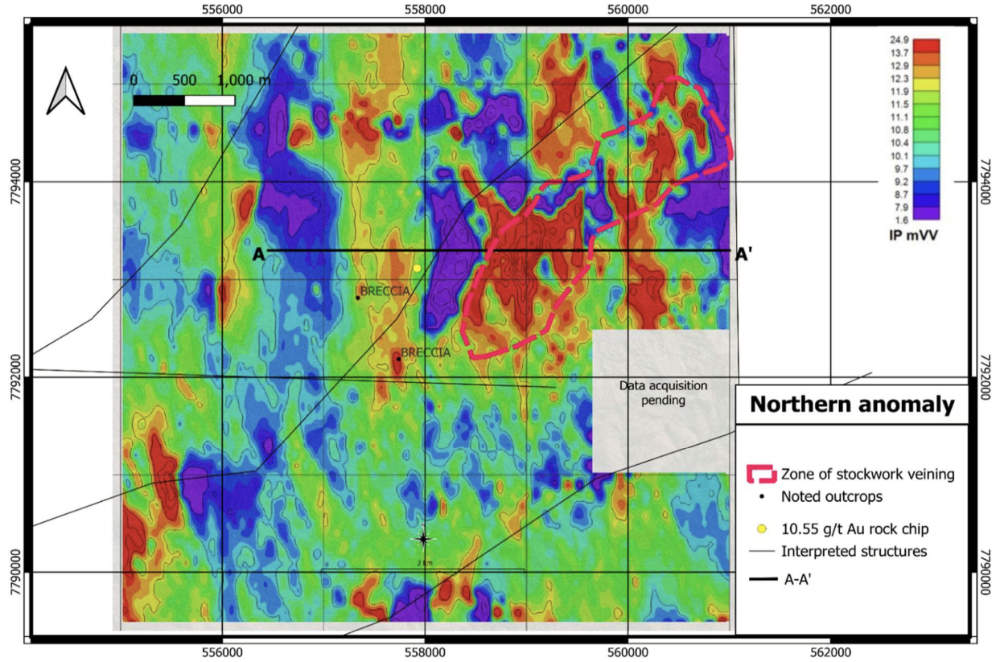Great Southern and Gold Fields spot exciting potential porphyry system at Edinburgh Park

Great Southern Mining and Gold Fields’ IP anomaly in Edinburgh Park could host an intrusion-related or epithermal gold-copper system. Pic: Getty Images
- Great Southern Mining, Gold Fields JV identify large-scale IP anomaly in the Edinburgh Park project in Queensland
- Anomaly interpreted to porphyry system hosting large-scale (over 2 km wide) intrusive related gold-copper and/or epithermal gold deposit
- 3D IP survey to be carried out to define the target and improve exploration model ahead of drilling in 2025
Special Report: Great Southern Mining and its JV partner, $21Bn capped global gold miner, Gold Fields, have identified a shallow, large-scale induced polarisation anomaly in an area of the Edinburgh Park project with elevated gold, silver, copper and molybdenum in rock chip and soil samples.
The anomaly is interpreted to be a porphyry system that could host a large-scale intrusive related gold-copper and/or epithermal gold deposit.
Importantly for Great Southern Mining (ASX:GSN), the identification of the anomaly marks an early success of its joint venture with G Ex Australia, a wholly-owned subsidiary of Gold Fields (NYSE:GFI) that is earning a 75% interest in the project by spending $15m on exploration over six years.
The 1750sq km project surrounds the ~1.7Moz equivalent Mt Carlton gold-silver-copper mine near Townsville, northern Queensland. GSN’s Executive Chairman, John Terpu, was part of the team at Conquest Mining (now Evolution Mining) that discovered the Mt Carlton deposit.
“Many of our long-term shareholders, who also shared in the success of the Mt Carlton discovery, will be very excited about this latest prospect,” GSN managing director Matthew Keane said.
“This is an exciting development for the Edinburgh Park project. The scale of this IP anomaly, combined with coincident geochemical anomalism, favourable surface geology, and inferred structural trends, marks it as a prime target for a significant intrusion-related or epithermal gold-copper system.
“Both GSN and Gold Fields are eager to drill test this target, which is likely to commence in 2025 once the northern Queensland wet season has subsided. In the meantime, ongoing geophysical surveys and on-ground mapping have the potential to generate further targets within previously identified and newly identified target areas.”

IP anomaly
The extensive chargeability anomaly was delineated by a gradient array IP survey at a northern prospect within the project.
Preliminary processing of the data has indicated that a sulphide halo around a preserved porphyry system could be present while an alternative interpretation suggests that the strong IP response to the east could directly correlate with an intrusion-related system like the >3Moz Mount Leyshon gold-silver mine about 120km to the west.
Elevated metals and their spatial zonation noted in rock chip and surface soil sampling support an underlying porphyry system while rock chips of outcropping stockwork veining have returned grades of up to 10.5g/t gold.
Field mapping has also confirmed the presence of sulphides in outcropping geology over the anomaly.
Next steps
The JV will follow-up the IP survey with a 3D IP survey this month to define the target and improve the exploration model ahead of drilling.
Drill testing is expected to begin in 2025 once heritage surveys have been completed and the northern Queensland wet season ends.
Other work includes ongoing IP surveys at the Molongle and Mt Dillon target areas, helicopter-borne aeromagnetic surveys, World View 3 optical imagery as well as mapping and ground truthing by Gold Fields’ geologists and consultants including highly regarded porphyry specialist geologist Nick Tate.
This article was developed in collaboration with Great Southern Mining, a Stockhead advertiser at the time of publishing.
This article does not constitute financial product advice. You should consider obtaining independent advice before making any financial decisions.
Related Topics

UNLOCK INSIGHTS
Discover the untold stories of emerging ASX stocks.
Daily news and expert analysis, it's free to subscribe.
By proceeding, you confirm you understand that we handle personal information in accordance with our Privacy Policy.








